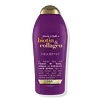What's inside
What's inside
 Key Ingredients
Key Ingredients

No key ingredients
 Benefits
Benefits

 Concerns
Concerns

 Ingredients Side-by-side
Ingredients Side-by-side

Water
Skin ConditioningSodium C14-16 Olefin Sulfonate
CleansingCocamidopropyl Betaine
CleansingBiotin
AntiseborrhoeicHydrolyzed Collagen
EmollientHydrolyzed Wheat Protein
Skin ConditioningEthyltrimonium Chloride Methacrylate/Hydrolyzed Wheat Protein Copolymer
Polyquaternium-22
PEG-7 Amodimethicone
HumectantLinoleamidopropyl Pg-Dimonium Chloride Phosphate
Polyquaternium-39
Sodium Hydrolyzed Potato Starch Dodecenylsuccinate
PEG-150 Pentaerythrityl Tetrastearate
EmulsifyingPPG-2 Hydroxyethyl Cocamide
EmulsifyingLaureth-4
EmulsifyingGlycol Distearate
EmollientPropylene Glycol
HumectantAcrylates/C10-30 Alkyl Acrylate Crosspolymer
Emulsion StabilisingHexylene Glycol
EmulsifyingSodium Citrate
BufferingCitric Acid
BufferingSodium Hydroxide
BufferingSodium Benzoate
MaskingParfum
MaskingCI 60730
Cosmetic ColorantCI 16035
Cosmetic ColorantCI 19140
Cosmetic ColorantWater, Sodium C14-16 Olefin Sulfonate, Cocamidopropyl Betaine, Biotin, Hydrolyzed Collagen, Hydrolyzed Wheat Protein, Ethyltrimonium Chloride Methacrylate/Hydrolyzed Wheat Protein Copolymer, Polyquaternium-22, PEG-7 Amodimethicone, Linoleamidopropyl Pg-Dimonium Chloride Phosphate, Polyquaternium-39, Sodium Hydrolyzed Potato Starch Dodecenylsuccinate, PEG-150 Pentaerythrityl Tetrastearate, PPG-2 Hydroxyethyl Cocamide, Laureth-4, Glycol Distearate, Propylene Glycol, Acrylates/C10-30 Alkyl Acrylate Crosspolymer, Hexylene Glycol, Sodium Citrate, Citric Acid, Sodium Hydroxide, Sodium Benzoate, Parfum, CI 60730, CI 16035, CI 19140
Water
Skin ConditioningCetearyl Alcohol
EmollientBehentrimonium Chloride
PreservativeCetyl Esters
EmollientLactic Acid
BufferingArginine
MaskingTrideceth-6
EmulsifyingChlorhexidine Digluconate
AntimicrobialLimonene
PerfumingBenzoic Acid
MaskingPanthenol
Skin ConditioningAmodimethicone
Isopropyl Alcohol
Solvent2-Oleamido-1,3-Octadecanediol
Skin ConditioningBiotin
AntiseborrhoeicCetrimonium Chloride
AntimicrobialParfum
MaskingCeramide AP
Skin ConditioningIngredients Explained
These ingredients are found in both products.
Ingredients higher up in an ingredient list are typically present in a larger amount.
Biotin is a B vitamin that is naturally produced by our bodies. It is also called Vitamin H.
Our bodies use biotin in the metabolism process. It also helps our bodies use enzymes and move nutrients around. A biotin deficiency can lead to brittle hair and nails.
More research is needed on applying biotin topically. However, taking biotin orally has been shown to help nourish the skin, hair, and nails. They play a role in forming skin-hydrating fatty acids.
Biotin is water-soluble. It can be found in foods such as fish, eggs, dairy, nuts, and meat. Vitamin H stands for "haar" and "haut". These are the German words for hair and skin.
Learn more about BiotinParfum is a catch-all term for an ingredient or more that is used to give a scent to products.
Also called "fragrance", this ingredient can be a blend of hundreds of chemicals or plant oils. This means every product with "fragrance" or "parfum" in the ingredients list is a different mixture.
For instance, Habanolide is a proprietary trade name for a specific aroma chemical. When used as a fragrance ingredient in cosmetics, most aroma chemicals fall under the broad labeling category of “FRAGRANCE” or “PARFUM” according to EU and US regulations.
The term 'parfum' or 'fragrance' is not regulated in many countries. In many cases, it is up to the brand to define this term.
For instance, many brands choose to label themselves as "fragrance-free" because they are not using synthetic fragrances. However, their products may still contain ingredients such as essential oils that are considered a fragrance by INCI standards.
One example is Calendula flower extract. Calendula is an essential oil that still imparts a scent or 'fragrance'.
Depending on the blend, the ingredients in the mixture can cause allergies and sensitivities on the skin. Some ingredients that are known EU allergens include linalool and citronellol.
Parfum can also be used to mask or cover an unpleasant scent.
The bottom line is: not all fragrances/parfum/ingredients are created equally. If you are worried about fragrances, we recommend taking a closer look at an ingredient. And of course, we always recommend speaking with a professional.
Learn more about ParfumWater. It's the most common cosmetic ingredient of all. You'll usually see it at the top of ingredient lists, meaning that it makes up the largest part of the product.
So why is it so popular? Water most often acts as a solvent - this means that it helps dissolve other ingredients into the formulation.
You'll also recognize water as that liquid we all need to stay alive. If you see this, drink a glass of water. Stay hydrated!
Learn more about Water